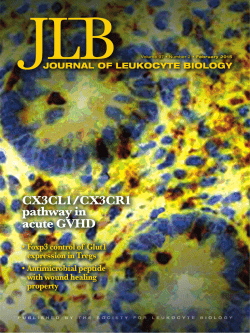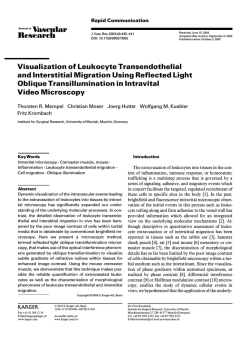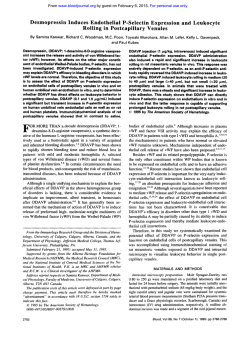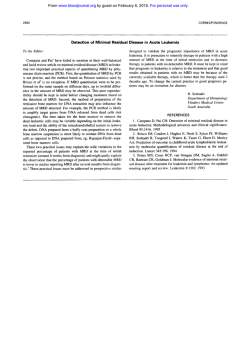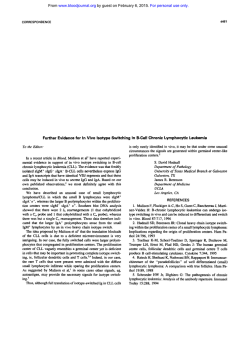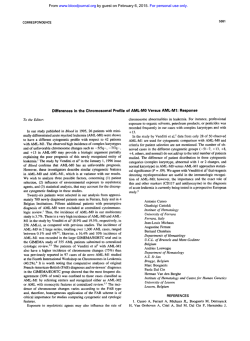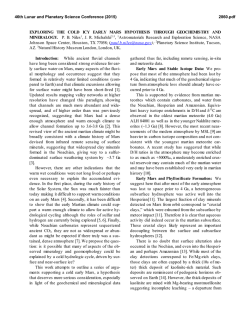
Inhibition of Leukocyte Rolling in Venules by Protamine and
From www.bloodjournal.org by guest on February 6, 2015. For personal use only. Inhibition of Leukocyte Rolling in Venules by Protamine and Sulfated Polysaccharides By Geert Jan Tangelder and Karl-E. Arfors Intravital video microscopy was used to investigate leukocyte marginationin 80 mesenteric venules (19 to 54 bm) of 50 anesthetized rabbits. After intravenous (IV) bolus injection, sulfated polysaccharides reduced in a reversible and dosedependent way the number of leukocytes rolling slowly along the venular wall. The presence of sulfate groups is essential because other negatively charged or neutralpolysaccharides had no effect. It was not caused by an increase in RBC velocity or chelation of divalent cations. Inhibition by sulfated dextrans (n = 7) was independent of molecular weight (mol wt 13,000 to 500,000) but was influenced by the average number of sulfate groups per monosaccharide. With substitution 0.13, the gO%-inhibition dose was 104 mg/kg, with 0.7 it was 56 mg/kg, and between substitution 1 and 2 it ranged from 20 to 23 mg/kg. At 100 mg/kg, plasma concentra- tion was 0.6 to 0.7 mg/mL. Xylan sulfate (mol wt 6,000, substitution 1.8) gave 90% inhibition at 11 mg/kg, and heparin gave 90% inhibition at 97 mg/kg. Duration of inhibition (0.5 to 2 hours) depended on mol wt and appeared to be related to plasma clearance. Because protamine also inhibited rolling (12 mg/kg; <10 minutes), we propose that repetitive formation and breakup of ionic bonds between sulfate groups and positivelycharged amino acids is involved in leukocyte rolling. During inhibition of rolling, systemic lymphocyte/monocytelevels appeared to increase. Granulocyte counts did not change, indicating that rolling is not the main mechanism responsible for the marginal granulocyte pool. o 1991 by The American Society of Hematology. I tized with 20% urethane (8 to 10 mLkg), injected in a marginal ear vein. A catheter was placed in the left jugular vein for additional small doses of urethane and injection of substances. A tracheal tube was placed to facilitate breathing. Rectal temperature (36" to 39°C throughout the experiments) was used to control the heating pad of the animal. In 20 animals, a catheter was positioned in the right carotid artery for collection of blood and measurement of blood pressure (external transducer: Century Technology Company [CTC], Inglewood, CA; CP-01). Gas values and pH of blood samples were measured with an acid-base analyzer (ABL 3, radiometer). Throughout these experiments, values of mean arterial pressure (MAP) generally were within 70 to 90 mm Hg, arterial pH within 7.30 to 7.45, PCO, 30 to 50 mm Hg, and PO, 70 to 100 mm Hg. Leukocyte levels in the systemic circulation were determined with a Burker chamber. Blood was collected in Turks solution (0.2 mg Gentian violet in 1 mL glacial acetic acid, 6.25% volhol). Shortly after induction of anesthesia, but before injection of any substance, total leukocyte count ranged from 2.7 to 9.0 x 103/pL (median 5.85). Monomorphonuclear cell counts, ie, lymphocytes and monocytes, ranged from 1.5 to 5.6 x 103/pL(median 3.35); and polymorphonuclear counts, ie, granulocytes, ranged from 0.8 to 5.7 x 103/pL (median 2.15). Granulocyte counts as a percentage of total leukocyte counts ranged from 23% to 64% (median 39.5%). Cell counts remained relatively constant during the first 1.5 to 2 hours of an experiment, but thereafter started to increase. At approximately 3 hours, total leukocyte counts were on the average 2.5 to 3.0 times the initial value. N TISSUES prepared for intravital microscopic observation, leukocytes are often observed rolling or sliding along the wall of venules. Their velocity is distinctly less than that of the other blood Leukocyte rolling is usually not observed in arterioles. It is probably the first step of leukocyte margination in venules during inflammatory processes, ultimately leading to prolonged adhesion, diapedesis, and extravascular migration.) In addition, rolling might be one of the mechanisms responsible for the existence of the marginal leukocyte ~ 0 0 1 s .The ~ cells in these pools can be rapidly mobilized into the circulation: Much is known about the biophysical aspects of leukocyte rolling in venule^'^^^^^*; however, the cell surface structures mediating rolling have not been explored. Besides glycoproteins: proteoglycans are also involved in cell adhesion phenomena." They contain long and negatively charged polysaccharide chains such as chondroitin sulfate, dermatan sulfate, and heparan sulfate, all of which can be synthesized by endothelial cells." Content and composition of endothelial cell surface proteoglycans may differ depending on vessel type and location, even in microvessels." In addition, sulfated macromolecules appear to be involved in lymphocyte recirculation.' Therefore, sulfated polysaccharide chains may play a role in the rolling of leukocytes along venular endothelium. We wished to investigate in vivo whether sulfated polysaccharides injected intravenously (IV) could block binding sites important for leukocyte rolling. When these substances proved to inhibit leukocyte rolling, additional experiments were performed to determine the possible mechanism, including studies examining the role of the negative electrical charge. Whether rolling contributed to formation of the marginal leukocyte pools was also evaluated. In addition, experiments were performed with protamine, a positively charged polypeptide that readily binds to sulfated polysaccharides." MATERIALS AND METHODS Animals and intravital microscom. Fifty New Zealand White rabbits of either sex (weight 1.7 to 3.2 kg) received diazepam intramuscularly (IM 4 to 5 mgkg). Thereafter, they were anestheBlood, Vol 77, No 7 (April I), 1991: pp 1565-1571 From La Jolla Institute for Experimental Medicine, La Jolla, and the Department of Physiology, University of Limburg, Maastricht, The Netherlands. Submitted August 9,1990; accepted November 27, 1990. Suppried by Grant No. S91-156from the Netherlands organization for the advancement ofpure research (ZWO). Address reprint requests to G.J. Tangelder, MD, PhD, Depamnent of Physiology, Biomedical Center, University of LimbuT, PO Box 616, 6200 MD Maastricht, The Netherlands. The publication costs of this article were defrayed in pari by page charge payment. This article must therefore be hereby marked "advertisement" in accordance with 18 U.S.C. section I734 solely to indicate this fact. 0 1991 by The American Society of Hematology. 0006-4971/91/7707-0022$3.00/0 1565 From www.bloodjournal.org by guest on February 6, 2015. For personal use only. 1566 TANGELDER AND ARFORS For intravital microscopic observation, the mesentery was used. Leukocyte rolling is invariably present in this thin and transparent tissue after its exposure. Through a midline abdominal incision, the distal part of the ileum was exteriorized. The mesenterywas spread over a siliconized glass plate mounted in an electrically heated microscope table (37°C). Care was taken not to touch or stretch the mesentery itself. The preparation was continuously superfused with a buffered (pH 7.4) Krebs-Henseleit or Tyrode’s solution kept at 36“to 37°C. The bowels were kept moist with overlying wet gauze and covered with Saran wrap to minimize evaporation and cooling. Preparations were allowed to stabilize for at least 10 minutes. In 22 animals, a second fresh mesenteric loop was exposed after 1 to 2 hours. Most of the experiments were performed within 2.5 hours after exposure of a mesenteric loop (median 80 minutes, maximum 4 hours). Observations were made with a Leitz intravital microscope, using water-immersion objectives (salt water [SW] 25 X or ultropak objective [UO] 23 X ,numerical aperture 0.6 and 0.55, respectively). Transillumination was performed with a tungsten lamp. In all experiments, the level of sharp focus was in the median plane of a venule. Images were recorded on videotape (Panasonic or MGA) through a TV camera (Panasonic or SIT). A zoom lens (Leitz) was used to obtain a final magnification at the front plane of the TV camera of 50X. Vessel diameters were measured with vernier calipers. In three animals, venular RBC velocity was measured with the dual-slit method,I4using transillumination with a mercury arc. In three animals, we performed fluorescence microscopy. The intravascular leukocytes were labeled by IV injection of 2.8 to 3.0 mg/kg acridine orange (Chroma, FRG; 0.2% in physiologic saline).” They were visualized with flashes from a xenon arc (Chadwick Helmuth power supply), using incident illumination (Leitz Ploemopak, excitation filter BG12 and BG38; dichroic mirror K490 nm; barrier filter 530 nm). Substances injected to influence leukocyte rolling. The polysaccharides used are shown in Tables 1 and 2, except a sulfated dextran with molecular weight (mol wt) 70,000 and degree of substitution 0.07, ie, average number of sulfate groups per monosaccharide. The structure of a polysaccharide substituted with electrically charged groups is shown in Fig 1. Dextrans were obtained from Pharmacia Fine Chemicals (Uppsala, Sweden). The neutral dextrans and FITC-labeled dextran, which is slightly negative charged (Table 2), as well as the dextran sulfate with mol wt 500,000 (Table 1), were obtained commercially. The other dextrans were synthesized and purified with salt precipitation by Dr T. de Belder (Pharmacia AB, Uppsala). Xylan sulfate was purchased as SP54 from Bene Chemie (Munchen, FRG). Its xylose units (a pentose) have a ring structure Table 1. Sulfated PolysaccharidesInhibiting Leukocyte Rolling Type of Molecular Degree of Substance Weight Substitution* Xylan Dextran Dextran Dextran Heparin 6,000 13,100 13,500 59,400 70,000 500,000 70,000 70,000 13,000 1.8 2.0 1.22 1.12 1.55 1.9 0.7 0.13 1.3 90% Inhibition (dose,mglkglt 11.1 (10.9-18.3) 22.5 (18.7-26.6) 22.3 (18.5-28.7) 22.2 (22.1-26.5) 22.0 (19.5-25.5) 20.2 (18.9-25.4) 56.1 (47.2-58.5) 103.7 (97.8-116.5) 97.1 (86.9-110.7) Fined Polynomial Order, r* 2 2 1 2 1 2 2 2 1 0.990 0.984 0.895 0.990 0.979 0.989 0.998 0.999 0.972 *Average number of sulfate groups added per monosaccharide; heparin contained carboxyl groups as well (substitution0.5). t95% Confidence limits in parentheses. SP < ,001 in all cases. Table 2. Substances With No Influence on Leukocyte Rolling Substance Dextran (neutral) Dextran Dextran carboxymethyl Glucose-6-sulfate Sodium sulfate Molecular Weight Degree of Substitution* Dose (mg/kg)t 70,000 500,000 - 150,000 70,000 150,000 298 142 0.1 0.85 0.11 1.o 220 80 150 415 330 32 108 - - ‘Average number of FITC, carboxymethyl, or sulfate groups added per monosaccharide. tup to and including the doses used. similar to that of glucose (a hexose, Fig l), but without the sixth carbon group; they are linked 1 to 4.16 Heparin was obtained from Lyphomed (Rosemont, IL) and Organon (Oss, Holland), with a potency of USP 140 to 160lmg (10,000 USPlmL). Its hexose units contain both carboxyl and sulfate groups. Commercial preparations range in mol wt from 5,000 to 30,000 with a mean value of 12,000 to 15,000.’’ Protamine (mol wt -4,000)13 was obtained as protamine sulfate from Lilly (10 mg/mL). Glucose-6-sulfate was purchased from Sigma, and sodium sulfate, calcium chloride, and magnesium chloride were purchased from Mallinckrodt. Substances were dissolved (1% to 10%) in physiologic saline or water, yielding an isotonic solution. They were injected IV as a bolus (1 to 8 mL, lasting 10 to 30 s). Often a series of injections was given (maximum 6; interval 2 to 5 minutes). Cumulative doses were then used to construct a dose-response curve. Because of short duration of the effect, only the first injection was used with protamine and xylan, and the first and second were used for the substances with mol wt 13,000 (Table 1). In two animals, plasma concentrations of the sulfated dextran with substitution 0.13 were determined. After injection of 100 mg/kg, samples were taken at 1 and 5 and then every 10 minutes. After acid hydrolysis in 1 N HCI (3 hours at 1Oo”C), the increase in glucose concentration was determined with the o-toluidine method.’“ The method could not be used at higher degrees of sulfate substitution. Analysis of rolling. Collecting venules (diameter > 15 wm) were selected with a sufficient number of rolling leukocytes. Video recordings for off-line analysis were made before, during, and after an injection (series). In vessels of this size, the number of leukocytes rolling on the endothelium was not influenced by differencesin blood flow velocity.’.’’ As observed in many rabbits,” blood flow velocity in mesenteric venules (20 to 40 pm) ranged from 1 to 6 mmls. Figure 2 (top) shows leukocyte rolling. Leukocytes indicated as 1 and 2 move slowly in a rolling or sliding fashion along the vessel wall, with a velocity of less than 50 ~ 4 s This . is 1 to 2 orders of I SO@ Fig 1. Schematic of molecular structure of a sulfated polysaccharide (sulfated dextran). The average number of sulfate groups per monosaccharide or degree of substitution is 1 in this example. The distribution of sulfate groups may be inhomogeneous. From www.bloodjournal.org by guest on February 6, 2015. For personal use only. INHIBITION OF LEUKOCYTE ROLLING IN VENULES 1567 Fig 2 Example of a mesenteric venule (32 to 33 pm) before and after inhibitionof leukocyterolling by a sulfated dextran (mol wt 59,400; 43 mg/kg). Top two panels (before inhibition): in 1 second, leukocytes marked 1 and 2 moved less than 50 pm, the distance indicated by the white bar in the bottom right panel. Direction of flow is from left to right (arrow). Top left panel: *Leukocytes that did not roll but adhered firmly to the vessel wall. These cells remained after inhibitionof rolling (bottom panels). magnitude less than blood flow velocity. Individual cells moving at flow velocity move too quickly to be detectable by the eye when continuous illumination is used. Therefore, all moving WBC that could be detected by eye were considered rolling cells. They either moved steadily or alternated short periods of almost complete standstill with a quicker move to another position at the wall. Leukocytes rolling out of focus could also be detected easily. Leukocyte rolling was quantified from video images, if necessary at reduced speed. We counted in triplicate or duplicate the number of all leukocytes rolling through a vessel segment (length one to two diameters) during a period of 1to 7 minutes, depending on the number of rollers. Cells present in the segment at the beginning of the period of counting were not included. Rolling was expressed as the average number of cells passing per minute. For construction of dose-response curves, we expressed the number of rolling leukocytes remaining after an injection as a percentage of the number of rolling cells in the control situation (Fig 3). Stat3tics. Data were analyzed with SPSS/PC+ statistical package (SPSS, Chicago, IL). Stray values were defined according to Tukey as outliers or extremes in a box-plot?' In all tests, a P-value greater than 0.05 was considered nonsignificant. Correlations were performed with the Spearman rank test, except for dose-response relations. Paired data groups were compared (two-sided) with the Wilcoxon signed-rank test. ff 1 Multiple regression analysis was used to describe the doseresponse curves?' Starting with straight line regression, we fitted successivehigher order polynomials. Significanceof a fit and of the improvement by adding an extra term were tested with the F statistic. In two curves, significant improvement by a higher (third) order term was caused solely by the presence of one high dose point lying far beyond the 90%-inhibition dose. These two points were therefore excluded from the analysis. An example is the point at 80 mgkg (open diamond) of the left curve shown in Fig 3. The appropriate fit (first or second order) was used to calculate the dose giving 90% inhibition. For comparison, 95% confidence intervals were calculated using the 95% confidence bands" of the best fitted straight lines (r 0.90 to 0.98, P < .001).In four curves, the highest data point was excluded. An example is the point at 149 mgkg in the right curve of Fig 3. The 90%-inhibition doses based on these straight lines differed from the former by less than 2.5 and 4 mgkg for the first six and last three substances in Table 1, respectively. RESULTS In 80 venules, leukocyte rolling was observed before (control) and during 93 injections or injection series. Venular diameters ranged from 19 to 54 pm (median 32 logdose 2 Fig 3. Dose-responsecurves with best f ~ ofs two sulfated dextrans. Concomitant log dose-affect plots (inset) with effect shown as percentageof inhibition. For the substance with dose-response curve shown at left (open symbols), mol wt was 59,400 and degree = 100.2 - 6 . 2 1 + ~ 0.096~'; of substitutionwas 1 . 1 2 1 ~ r = 991, P < .001). For the substance with doseresponse curve shown at right (closed symbols) 70,000 and 0.13, respectively ( y = 99.6 1 . 3 5 0.OOW; r = .999, P < .001). Different symbols in the dose-response curves represent experiments in different animals; level of 90% inhibkion (dashed line). + Dose (mglkg) - From www.bloodjournal.org by guest on February 6, 2015. For personal use only. 1568 pm). Control values of leukocyte rolling ranged from 12 to 188/min (stray value 223). The distribution was skewed to the right with a mode of 37/min (median 64/min). Skewness was 1.03 (SE 0.25), which is significantly higher than zero, the value expected in case of a normal distribution. No correlations could be found between the number of rolling leukocytes and vessel diameter or time elapsed after the abdomen was opened. Sulfated po&saccharides. Table 1 shows the sulfated polysaccharides that were able to inhibit leukocyte rolling. Within seconds after injection, the number of rolling leukocytes decreased or even disappeared completely, depending on the dose. In Fig 2, leukocyte rolling, illustrated at t = 0 and 1second, could no longer be observed anymore after injection (t = 8.34 and 9.34 seconds). In contrast, WBC that had stuck to the wall for several minutes were not removed. Inhibition of leukocyte rolling by sulfated polysaccharides was a reversible phenomenon. With the lower mol-wt substances (mol wt < 15,000), rolling cells returned after 10 to 20 minutes and had usually reached levels of about 50% to 100% of control within 20 to 40 minutes. With mol wt 60,000 to 70,000, inhibition lasted 40 to 70 minutes; with mol wt 500,000 inhibition lasted for the remainder of the experiment, ie, at least 90 to 105 minutes. Plasma concentrations of the sulfated dextran with mol wt 70,000 and substitution 0.13 decreased rapidly. Within 45 to 65 minutes after injection of 100 mgikg, 90% had been removed. One minute after injection of this dose, the plasma concentration was 0.6 to 0.7 mg/mL. This is only 25% of the value expected on the basis of the average plasma volume (39 mL/kg) of rabbits?' Figure 3 shows the dose-response curves of two dextrans with similar mol wt (60,000 to 70,000) but different degree of substitution. The substance with substitution 0.13 (Fig 3, right) was far less effective than that with substitution 1.12. Each curve was best fitted with a second-order polynomial, also shown in Fig 3. When the dose-axis of each curve was normalized with respect to the intersection of its best fit with the 90%-inhibition level (Fig 3), both curves coincided, or, alternatively, a log dose-effect plot of both curves indicated a similar slope (Fig 3, inset). This suggests that the difference in potency of both substances is related to a difference in affinity for the cell surface structures to which they bind?3 The doses yielding 90% inhibition are shown in Table 1, as well as the correlation coefficients ( I ) and polynomial order of the appropriate fits. Comparison of the 95%confidence limits of these doses indicates that (1) the xylan is significantly more effective than the dextrans, (2) dextrans with a degree of substitution exceeding unity are equally effective despite the huge variation in mol wt, (3) the effect decreases with substitution below unity, and (4) heparin is far less effective than the other substances with a high degree of substitution ( > 1). Injection of sulfated dextrans at doses inhibiting leukocyte rolling did not cause a change in venular RBC velocity (range 0.8 to 2.4 mm/s; four venules), except for the 500,000 mol-wt dextran. This substance could cause a transitory TANGELDER AND ARFORS decrease in velocity (maximum 50%) for 5 to 10 minutes. Injection of sulfated polysaccharides did not change blood pressure (BP). Other substances and protamine. The sulfated dextran with degree of substitution 0.07 did not reduce the number of rolling leukocytes more than about 50%, up to and including a dose of 600 mgikg. The substances that had no influence on the number of rolling leukocytes are shown in Table 2; the carboxymethyl-dextrans shown in Table 2 have a degree of substitution similar to that of the last two sulfated dextrans shown in Table 1. Comparison of these four dextrans showed that negative charge alone is not enough to influence WBC rolling. Inhibition of leukocyte rolling specifically requires the presence of sulfate groups. Free calcium or magnesium ions have been suggested to be important for leukocyte rolling.' Therefore, we tested in two animals whether inhibition by sulfated polysaccharides could have been caused by a sequestration of these ions. Injection of excess calcium or magnesium ions, however, up to and including 10 times the dose needed to saturate all chelating sites, did not cause leukocyte rolling to recur. Injection of calcium or magnesium chloride alone did not influence the number of rolling leukocytes. Protamine was also able to- inhibit leukocyte rolling. After a first injection, the effect was short. Rolling leukocytes started to return within 30 to 60 seconds and were back at 50% to 100% of control after 5 to 10 minutes. The dose-response curve was best fitted with a second-order polynomial (y = 100.4 -ll.&c + 0.352, r = .98, P < .001). The 90%-inhibition dose was 11.8 mgikg (10.1 to 13.8; 95% confidence limits). Each successive injection within a series caused a new decrease in leukocyte rolling, which then lasted longer. After a cumulative dose of 20 to 25 mag, return to control levels took approximately 20 minutes. At these latter doses, protamine could induce a transient decrease in blood flow velocity, probably caused by a decrease in BP. Even at doses of 5 to 10 mg/kg, short decreases (10% to 20%) in BP were noted. Influence on systemic leukocyte counts. Table 3 shows that disappearance of rolling leukocytes as caused by the substances shown in Table 1 did not result from a removal of WBCs from the circulation. The same was true of protamine. The last two dextrans shown in Table 1 could at their highest doses induce decreases in granulocyte counts to 30% to 40% of control; however, these decreases usually occurred 1 or more minutes after leukocyte rolling had disappeared. Experiments with fluorescent labeling confirmed that circulating leukocytes were indeed delivered to and flowing in the venules when leukocyte rolling had been inhibited. Table 3. Systemic Leukocyte Counts During Inhibitionof Rolling by Sulfated Polysaccharidesas Percentage of PieinjectionCount Duration of Experiment (h) Granulocytes Lymphocytes and Monocytes < 2 (n = 9) 2-4(n = 8) 90%' (65-190). NS 100% (70-239)t. NS 121% (75-133),P < .10 144% (73-315l.P< .05 'Median values, with range in parentheses. tone stray value of 632%. From www.bloodjournal.org by guest on February 6, 2015. For personal use only. 1569 INHIBITION OF LEUKOCYTE ROLLING IN VENULES All sulfated polysaccharides shown in Table 1 were used, except two dextrans (substitution 1.55 and 0.7). The pattern of leukocyte flux in venules became similar to that observed in arterioles, with leukocytes rapidly passing by, often in the center of the stream (Fig 4). Table 3 also indicates that inhibition of leukocyte rolling by sulfated polysaccharides did not increase the level of circulating granulocytes, eg, owing to mobilization of the marginal granulocyte pool. In contrast, the circulating lymphocytelmonocyte levels appeared to increase. Leukocyte counts remained relatively constant during the first 2 hours of an experiment, but thereafter started to increase. Because this might have influenced the comparison between postinjection and preinjection counts, Table 3 distinguishes between counts obtained before and after 2 hours. In the first group, the change in lymphocytelmonocyte counts approached statistical significance. The data in both groups support each other, however, and in combination suggest an increase in lymphocyte andlor monocyte levels Fig 4. Fluorescentlylabeled leukocytes rolling in a venule (38 km; top) and flowing in the midstream (bottom) after injection of the sulfated xylan (15 mglkg). Direction of flow (arrow). The two cells at the wall in the lower picture are adherent leukocytes. The tail of after-images of leukocytes flowing in the midstream resulted from one flash in each TV frame (60/s) and slow camera decay. during inhibition of leukocyte rolling by a sulfated polysaccharide. DISCUSSION The present study showed in vivo that sulfated polysaccharides are able to inhibit the rolling or sliding of leukocytes along the venular wall. Protamine, which is positively charged, also inhibits rolling. Inhibition is reversible and dose dependent. Leukocytes that had already adhered to the wall for some time remained. Inhibition by sulfated polysaccharides does not result solely from their negative charge: the presence of sulfate groups is essential. The effect increases with the number of sulfate groups up to about one per monosaccharide. The dose needed was independent of mol wt but was influenced by the type of polysaccharide. The inhibition was not caused by an increase in RBC velocity or chelation of divalent cations. The levels of circulating lymphocytes andlor monocytes appeared to increase, but granulocyte counts did not change during inhibition of leukocyte rolling. In the exposed rabbit mesenteries used in this study, leukocyte rolling was always present without application of chemotactic agents. This is also reported for mesentery of other No significant relation was found between the number of rolling leukocytes and the duration of an experiment, suggesting a relatively constant level of the inflammatory factors involved. These as yet unknown factors differ in their action from the often-used chemotactic agents formyl-methionyl-leucyl-phenyl-alanine(fMLP) and phorbol myristate acetate (PMA). Addition of fMLP to the superfusion solution reduces the number of rolling leukocytes in mesenteric venule^^^^^ As soon as fMLP reaches the preparation, the rolling cells immediately stick more firmly and permanently to the vessel wall. In contrast to PMA-stimulated leukocytes,2srolling cells in vivo appear to be round and do not show overt shape change with long pseudopods. Therefore, in vitro adhesion assays using these agents may represent firm, prolonged leukocyte sticking rather than rolling. The levels of wall shear stress in mesenteric venules are 29 dynes/cm2on the average?6 This is an order of magnitude higher than the levels at which in vitro leukocyte adhesion can be achieved. Adhesion of granulocytes to cultured human umbilical vein endothelium or artificial surfaces decreases with shear and is absent at shear stresses exceeding about 3 dynes/cm2,even after stimulation of one or both cell types with fMLP, PMA, or interIe~kin-l.~*~’*~* In contrast, in venules of the size used in our study the number of leukocytes rolling on the endothelium is not influenced by differences in blood flow velocity or wall shear rate.”” This is another reason why current in vitro assays are not representative of leukocyte rolling in venules. The source of endothelium used might be critical, because in arterioles that have the same flow conditions as venules leukocyte rolling is absent. The reduction in the number of leukocytes rolling on the endothelium after injection of a sulfated polysaccharide or protamine is not caused by a sudden increase in hydrodynamic dispersal forces acting on the rolling WBC. RBC From www.bloodjournal.org by guest on February 6, 2015. For personal use only. 1570 TANGELDER AND ARFORS velocity and BP did not increase. Moreover, if this had occurred, the neutral and other dextrans (Table 2) might have been expected to show an inhibitory effect as well. This latter finding also indicates that the inhibition did not result from an increase in plasma viscosity or osmolality. Changes in osmolality can influence leukocyte deformability.29 Inhibition of leukocyte rolling did not increase the level of circulating granulocytes. Approximately half to three fourths of the granulocytes inside the vascular compartment do not c i r ~ u l a t e . They ~ . ~ are present mainly in lung m i c r o v e ~ ~ e l ~and , ~ " ~this ~ ' marginal pool can be rapidly m~bilized."~~~' The finding that a reduction in the number of leukocytes rolling in mesenteric venules did not lead to an increase in circulating granulocyte counts indicates that this leukocyte-endothelial interaction is not the main mechanism responsible for the marginal granulocyte pool. In addition, it suggests that in noninflamed tissue granulocyte rolling is a rare phenomenon. Exposure of the mesentery probably induces a mild inflammatory response in this thin tissue. The reversible nature of the inhibition of leukocyte rolling by sulfated polysaccharides appears to be related to their plasma clearance. The 90%-inhibition dose of a sulfated dextran with mol wt 70,000 was cleared in about 1 hour. Rapid sequestration and desulfation mainly by the liver have been reported in humans for heparin and the xylan used in this A relation between plasma clearance and duration of inhibition might indicate that the molecular structures involved are only temporarily affected. This is supported by the short action of lower mol-wt substances such as heparin. The immediate effect after injection suggests that structures already present and involved in leukocyte rolling were blocked. Dextrans charged negatively with carboxymethyl groups had no effect on the number of rolling leukocytes; this probably was not caused by a lack in degree of ionization; eg, carboxy-methylcellulose,which like dextran consists of glucose units, has a pKa of 5.5.3' Hence, at blood pH its degree of ionization exceeds 98.5%. In vitro, binding of lymphocytes to autologous erythrocytes could be blocked effectively by sulfated polysaccharides but not by phosphated or carboxylated To be effective, the sulfate groups must be present on a sufficiently large molecule. Glucose-sulfate and sulfate ions had no effect. On the other hand, inhibition of rolling was independent of mol wt indicating that fewer molecules are needed of a large sulfated polysaccharide than of a small one as long as their total mass is the same. It suggests that a large polysaccharide molecule can simultaneously block more than one binding site important for leukocyte rolling. Heparin was far less effective than dextran or xylan sulfate. Xylan was more effective than the dextrans. These results indicate that in addition to the influence of the density of sulfate groups, the presence of other, nonfunctional moieties and type of sugar has an influence. Protamine also inhibited leukocyte rolling in a reversible way. It contains 80% to 90% arginine residues and binds readily to sulfated polysaccharides." Therefore, an analogous interaction may be involved in leukocyte rolling along venular endothelium. Negatively charged sulfate groups of proteoglycans on one cell could interact with positively charged arginine and/or lysine moieties of glycoproteins on the other. Repetitive formation and breakup of ionic bonds complies with the transitory nature of the interaction between both cells during rolling. If endothelial proteoglycans are involved in leukocyte rolling, differences in sulfate content, other substituted groups, and type of sugar might explain the difference in leukocyte rolling between arterioles and venules. In conclusion, sulfate groups but not other negatively charged moieties on polysaccharides can reversibly bind to and block in vivo molecular structures important for leukocyte rolling in venules. The positively charged arginine residues of protamine can do the same. These results leave intact the hypothesis that cell surface proteoglycans play a role in leukocyte rolling. Reduction in the number of rolling leukocytes in mesenteric venules did not lead to an increase in circulating granulocyte counts, indicating that this type of leukocyte-endothelial interaction is not the main mechanism responsible for the marginal granulocyte pool. ACKNOWLEDGMENT We are indebted to Sabrina Weijmer-van Velzen for technical assistance. REFERENCES 1. Atherton A, Born GVR: Quantitative investigations of the adhesiveness of circulating polymorphonuclearleukocytes to blood vessel walls. J Physiol222447,1972 2. Schmid-Schonbein GW, Usami S, Skalak R, Chien S: The interaction of leukocytes and erythrocytes in capillary and postcapillary vessels. Microvasc Res 19:45,1980 3. Harlan JM: Leukocyte-endothelial interactions. Blood 65: 513,1985 4. Bierman HR, Kelly KH, Cordes FL, Byron RL, Polhemus BS, Rappoport S: The release of leukocytes and platelets from the pulmonary circulation by epinephrine. Blood 7:683,1952 5. House SD, Lipowsky HH: Leukocyte-endothelium adhesion: Microhemodynamics in mesentery of the cat. Microvasc Res 34363,1987 6. House SD, Lipowsky HH: In vivo determination of the force of leukocyte-endothelium adhesion in the mesenteric microvasculature of the cat. Circ Res 63:658,1988 7. Mayrovitz HN, Kang SJ, Herscovici B, Sampsell RN: Leukocyte adherence initiation in skeletal muscle capillaries and venules. Microvasc Res 33:22,1987 8. Bagge U, Karlsson R: Maintenance of white blood cell margination at the passage through small venular junctions. Microvasc Res 2092,1980 9. Hogg N: The leukocyte integrins. Immunol Today 10:111, 1989 10. Rapraeger A, Jalkanen M, Bernfield M: Integral membrane proteoglycans as matrix receptors: role in cytoskeleton and matrix assembly at the epithelial cell surface, in Wight TN, Mecham RP From www.bloodjournal.org by guest on February 6, 2015. For personal use only. INHIBITION OF LEUKOCYTE ROLLING IN VENULES (eds): Biology of Proteoglycans. San Diego, CA, Academic, 1987, p 129 11. Heifetz A, Allen D: Biosynthesis of cell surface sulfated glycoproteins by cultured vascular endothelial cells. Biochemistry 21:171, 1982 12. Ausprunk DH, Boudreau CL, Nelson DA: Proteoglycans in the microvasculature: I. Histochemical localization in microvessels of the rabbit eye. Am J Pathol103:353,1981 13. Ando T, Yamasaki M, Suzuki K: Protamines: Isolation, characterization, structure and function, in Molecular Biology, Biochemistry and Biophysics 12. New York, Springer, 1973 14. Slaaf DW, Arts T, Jeurens TJM, Tangelder GJ, Reneman RS: Electronic measurement of red blood cell velocity and volume flow in microvessels, in Chayen J, Bitensky L (eds): Investigative Microtechniques in Medicine and Biology. New York, Dekker, 1984, p 327 15. Tangelder GJ, Slaaf DW, Reneman RS: Fluorescent labeling of blood platelets in vivo. Thromb Res 282303, 1982 16. MacGregor IR, Dawes J, Paton L, Pepper DS, Prowse CV, Smith M: Metabolism of sodium pentosan polysulphate in manCatabolism of iodinated derivatives. Thromb Haemost 51:321, 1984 17. Holmer E, Soderberg K, Bergqvist D, Lindahl U: Heparin and its low molecular weight derivatives: Anticoagulant and antithrombotic properties. Haemostasis 16:1, 1986 (suppl2) 18. Hultman E: Carbohydrates and related compounds. A Glucose, galactose, fructose, inulin and ketone bodies in blood and urine, in Curtius HCh, Roth M (eds): Clinical Biochemistry, Principles and Methods. Berlin, de Gruyter, 1974, p 908 19. Oude Egbrink M G A Thromboembolic reaction following vessel wall injury in arterioles and venules. Thesis, University of Limburg, Maastricht, The Netherlands, 1989 20. Tukey JW: Exploratory Data Analysis. Reading, MA, Addison-Wesley, 1977 21. Kleinbaum DG, Kupper LL: Applied Regression Analysis and Other Multivariable Methods. North Scituate, MA, Duxbury Press, 1978 22. Kozma C, Macklin W, Cummins LM, Mauer R: The anatomy, physiology and the biochemistry of the rabbit, in Weisbroth 1571 SH, Flatt RE, Kraus AL (eds): The Biology of the Laboratory Rabbit. San Diego, CA, Academic, 1974, p 50 23. Goodman Gilman A, Goodman LS, Rall TW,Murad F The Pharmacological Basis of Therapeutics. New York, Macmillan, 1985 24. Tangelder GJ, Neumann C, Arfors K-E: Reduction of leukocyte sticking by dextran-sulfate induced inhibition of leukocyte rolling. FASEB J 2:A 1881,1988 (abstr) 25. Ley K, Lundgren E, Berger E, Arfors K-E: Shear-dependent inhibition of granulocyte adhesion to cultured endothelium by dextran sulfate. Blood 73:1324,1989 26. Lipowsky HH, Kovalcheck S, Zweifach BW: The distribution of blood rheological parameters in the microvasculature of cat mesentery. Circ Res 43:738,1978 27. Lawrence MB, McIntire LV, Eskin SG: Effect of flow on polymorphonuclear leukocyte/endotheliaI cell adhesion. Blood 70:1284,1987 28. Lawrence MB, Smith C W ,Eskin SG, McIntire LV: Effect of venous shear stress on CD-18 mediated neutrophil adhesion to cultured endothelium. Blood 75227,1990 29. Chien S, Sung KLP, Skalak R, Schmid-Schonbein GW: Viscoelastic properties of leukocytes in passive deformation, in Bagge U, Born GVR, Gaehtgens P (eds): White Blood Cells: Morphology and Rheology as Related to Function. The Hague, Martinus Nijhoff, 1982, p 11 30. Doerschuk CM, Downey GP, Doherty DE, English D, Gie RP, Ohgami M, Worthen GS, Henson PM, Hogg J C Leukocyte and platelet margination within microvasculature of rabbit lungs. J Appl Physiol68:1956,1990 31. Hogg JC: Neutrophil kinetics and lung injury. Physiol Rev 67:1249, 1987 32. Dawes J, Pepper DS: Catabolism of low-dose heparin in man. Thromb Res 14845,1979 33. Windholz M, Budavari S, Blumetti RF, Otterbein ES (eds): The Merck Index. Rahway NJ, Merck, 1983 34. Parish CR, Rylatt DB, Snowden JM: Demonstration of lymphocyte surface lectins that recognize sulfated polysaccharides. J Cell Sci 67:145,1984 From www.bloodjournal.org by guest on February 6, 2015. For personal use only. 1991 77: 1565-1571 Inhibition of leukocyte rolling in venules by protamine and sulfated polysaccharides GJ Tangelder and KE Arfors Updated information and services can be found at: http://www.bloodjournal.org/content/77/7/1565.full.html Articles on similar topics can be found in the following Blood collections Information about reproducing this article in parts or in its entirety may be found online at: http://www.bloodjournal.org/site/misc/rights.xhtml#repub_requests Information about ordering reprints may be found online at: http://www.bloodjournal.org/site/misc/rights.xhtml#reprints Information about subscriptions and ASH membership may be found online at: http://www.bloodjournal.org/site/subscriptions/index.xhtml Blood (print ISSN 0006-4971, online ISSN 1528-0020), is published weekly by the American Society of Hematology, 2021 L St, NW, Suite 900, Washington DC 20036. Copyright 2011 by The American Society of Hematology; all rights reserved.
© Copyright 2025
